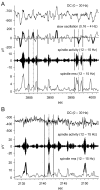Grouping of spindle activity during slow oscillations in human non-rapid eye movement sleep
- PMID: 12486189
- PMCID: PMC6758415
- DOI: 10.1523/JNEUROSCI.22-24-10941.2002
Grouping of spindle activity during slow oscillations in human non-rapid eye movement sleep
Abstract
Based on findings primarily in cats, the grouping of spindle activity and fast brain oscillations by slow oscillations during slow-wave sleep (SWS) has been proposed to represent an essential feature in the processing of memories during sleep. We examined whether a comparable grouping of spindle and fast activity coinciding with slow oscillations can be found in human SWS. For negative and positive half-waves of slow oscillations (dominant frequency, 0.7-0.8 Hz) identified during SWS in humans (n = 13), wave-triggered averages of root mean square (rms) activity in the theta (4-8 Hz), alpha (8-12 Hz), spindle (12-15 Hz), and beta (15-25 Hz) range were formed. Slow positive half-waves were linked to a pronounced and microV (23.4%; p < 0.001, with reference to baseline) at the midline central electrode (Cz). In contrast, spindle activity was suppressed during slow negative half-waves, on average by -0.65 +/- 0.06 microV at Cz (-22%; p < 0.001). An increase in spindle activity 400-500 msec after negative half-waves was more than twofold the increase during slow positive half-waves (p < 0.001). A similar although less pronounced dynamic was observed for beta activity, but not for alpha and theta frequencies. Discrete spindles identified during stages 2 and 3 of non-rapid eye movement (REM) sleep coincided with a discrete slow positive half-wave-like potential preceded by a pronounced negative half-wave (p < 0.01). These results provide the first evidence in humans of grouping of spindle and beta activity during slow oscillations. They support the concept that phases of cortical depolarization during slow oscillations, reflected by surface-positive (depth-negative) field potentials, drive the thalamocortical spindle activity. The drive is particularly strong during cortical depolarization, expressed as surface-positive field potentials.
Figures






Similar articles
-
Sleep spindle maturity promotes slow oscillation-spindle coupling across child and adolescent development.Elife. 2023 Nov 24;12:e83565. doi: 10.7554/eLife.83565. Elife. 2023. PMID: 37999945 Free PMC article.
-
Spindle and slow wave rhythms at slow wave sleep transitions are linked to strong shifts in the cortical direct current potential.Neuroscience. 2003;121(4):1047-53. doi: 10.1016/s0306-4522(03)00458-5. Neuroscience. 2003. PMID: 14580954
-
Dynamics of electroencephalographic sleep spindles and slow wave activity in men: effect of sleep deprivation.Brain Res. 1993 Oct 29;626(1-2):190-9. doi: 10.1016/0006-8993(93)90579-c. Brain Res. 1993. PMID: 8281430
-
The visual scoring of sleep and arousal in infants and children.J Clin Sleep Med. 2007 Mar 15;3(2):201-40. J Clin Sleep Med. 2007. PMID: 17557427 Review.
-
Slow oscillations orchestrating fast oscillations and memory consolidation.Prog Brain Res. 2011;193:93-110. doi: 10.1016/B978-0-444-53839-0.00007-7. Prog Brain Res. 2011. PMID: 21854958 Review.
Cited by
-
The impact of visual perceptual learning on sleep and local slow-wave initiation.J Neurosci. 2013 Feb 20;33(8):3323-31. doi: 10.1523/JNEUROSCI.0763-12.2013. J Neurosci. 2013. PMID: 23426660 Free PMC article. Clinical Trial.
-
The Contribution of Thalamocortical Core and Matrix Pathways to Sleep Spindles.Neural Plast. 2016;2016:3024342. doi: 10.1155/2016/3024342. Epub 2016 Apr 10. Neural Plast. 2016. PMID: 27144033 Free PMC article. Review.
-
Human gamma oscillations during slow wave sleep.PLoS One. 2012;7(4):e33477. doi: 10.1371/journal.pone.0033477. Epub 2012 Apr 4. PLoS One. 2012. PMID: 22496749 Free PMC article.
-
Pleasure of paying when using mobile payment: Evidence from EEG studies.Front Psychol. 2022 Oct 25;13:1004068. doi: 10.3389/fpsyg.2022.1004068. eCollection 2022. Front Psychol. 2022. PMID: 36389456 Free PMC article.
-
The human thalamus orchestrates neocortical oscillations during NREM sleep.Nat Commun. 2022 Sep 5;13(1):5231. doi: 10.1038/s41467-022-32840-w. Nat Commun. 2022. PMID: 36064855 Free PMC article.
References
-
- Achermann P, Borbély AA. Low-frequency (<1 Hz) oscillations in the human sleep electroencephalogram. Neuroscience. 1997;81:213–222. - PubMed
-
- Aeschbach D, Borbély AA. All-night dynamics of the human sleep EEG. J Sleep Res. 1993;2:70–81. - PubMed
-
- Amzica F, Steriade M. The K-complex: its slow (<1-Hz) rhythmicity and relation to delta waves. Neurology. 1997;49:952–959. - PubMed
-
- Bauer H, Korunka C, Leodolter M. Technical requirements for high-quality scalp DC recordings. Electroencephalogr Clin Neurophysiol. 1989;72:545–547. - PubMed
-
- Buzsáki G. Memory consolidation during sleep: a neurophysiological perspective. J Sleep Res. 1998;7 [Suppl 1]:17–23. - PubMed
Publication types
MeSH terms
LinkOut - more resources
Full Text Sources
Medical
Miscellaneous
